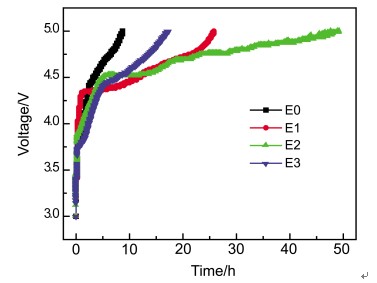化学学报 ›› 2013, Vol. 71 ›› Issue (05): 798-802.DOI: 10.6023/A12110964 上一篇 下一篇
研究论文
张治安a,b, 彭波a, 卢海a,b, 任春燕a, 贾明a,b, 赖延清a,b
Zhang Zhiana,b, Peng Boa, Lu Haia,b, Ren Chunyana, Jia Minga,b, Lai Yanqinga,b

选择苯甲醚、2-溴苯甲醚、3-溴苯甲醚作为锂离子电池有机电解液的防过充添加剂. 采用循环伏安测试、恒流充放电测试、电化学阻抗分析、扫描电镜分析等手段, 研究三种添加剂的防过充作用效果, 以及对LiNi1/3Co1/3Mn1/3O2 (NCM)正极性能的影响. 结果表明: 三种添加剂均具有合适的氧化电位和良好的氧化还原特性, 能够提高锂离子电池的防过充性能. 其中2-溴苯甲醚的防过充作用效果最优, 电池经0.1 C充电长达近50 h后才达到5 V截止电压, 且可承受过充的次数相对最多, 但该添加剂对NCM正极的循环性能影响较大; 苯甲醚的防过充效果仅次于2-溴苯甲醚, NCM正极在添加有苯甲醚的电解液中循环性能良好, 0.2 C充放电循环80次后容量仍能保持93.8%左右. 含上述三种添加剂的电池经过充后, 均会有一部分氧化还原产物吸附在NCM正极表面, 增加电池的整体阻抗, 其中含2-溴苯甲醚的电池表现最为明显.